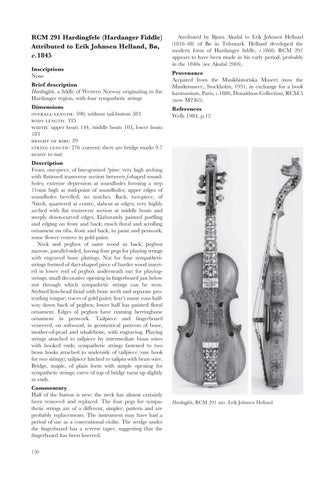50731-133-150
3/4/07
14:45
Page 150
RCM 291 Hardingfele (Hardanger Fiddle) Attributed to Erik Johnsen Helland, Bø, c.1845 Inscriptions None Brief description Hardingfele, a fiddle of Western Norway originating in the Hardanger region, with four sympathetic strings Dimensions : 590, without tail-button 583 : 335 : upper bouts 144, middle bouts 103, lower bouts 183 : 29 : 276 (current; there are bridge marks 9.7 nearer to nut)
Attributed by Bjørn Aksdal to Erik Johnsen Helland (1816–68) of Bø in Telemark. Helland developed the modern form of Hardanger fiddle, c.1860; RCM 291 appears to have been made in his early period, probably in the 1840s (see Aksdal 2005). Provenance Acquired from the Musikhistoriska Museet (now the Musikmuseet), Stockholm, 1951, in exchange for a book harmonium, Paris, c.1880, Donaldson Collection, RCM 5 (now M2365). References Wells 1984, p.12
Description Front, one-piece, of fine-grained ?pine: very high arching with flattened transverse section between f-shaped soundholes; extreme depression at soundholes forming a step 11mm high at mid-point of soundholes; upper edges of soundholes bevelled; no notches. Back, two-piece, of ?birch, quartered at centre, slabcut at edges; very highly arched with flat transverse section at middle bouts and steeply down-curved edges. Elaborately painted purfling and edging on front and back; much floral and scrolling ornament on ribs, front and back, in paint and penwork; some flower centres in gold paint. Neck and pegbox of same wood as back; pegbox narrow, parallel-sided, having four pegs for playing strings with engraved bone platings. Nut for four sympathetic strings formed of dart-shaped piece of harder wood inserted in lower end of pegbox underneath nut for playingstrings; small decorative opening in fingerboard just below nut through which sympathetic strings can be seen. Stylised lion-head finial with bone teeth and separate protruding tongue; traces of gold paint; lion’s mane runs halfway down back of pegbox; lower half has painted floral ornament. Edges of pegbox have running herringbone ornament in penwork. Tailpiece and fingerboard veneered, on softwood, in geometrical patterns of bone, mother-of-pearl and whalebone, with engraving. Playing strings attached to tailpiece by intermediate brass wires with hooked ends; sympathetic strings fastened to two brass hooks attached to underside of tailpiece (one hook for two strings); tailpiece hitched to tailpin with brass wire. Bridge, maple, of plain form with simple opening for sympathetic strings; curve of top of bridge turns up slightly at ends. Commentary Half of the button is new: the neck has almost certainly been removed and replaced. The four pegs for sympathetic strings are of a different, simpler, pattern and are probably replacements. The instrument may have had a period of use as a conventional violin. The wedge under the fingerboard has a reverse taper, suggesting that the fingerboard has been lowered. 150
Hardingfele, RCM 291 attr. Erik Johnsen Helland
